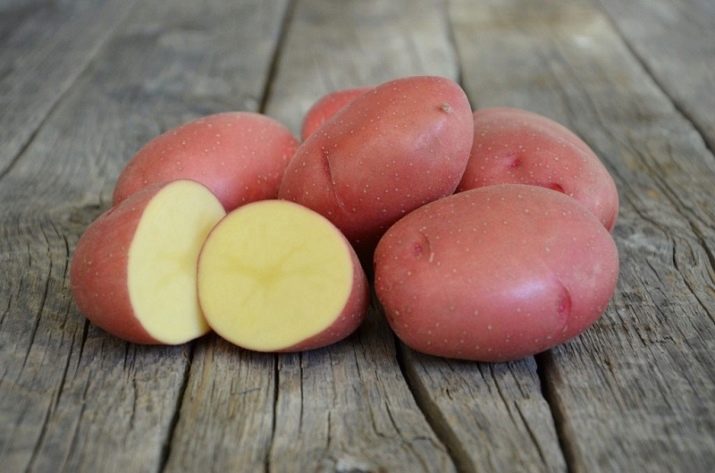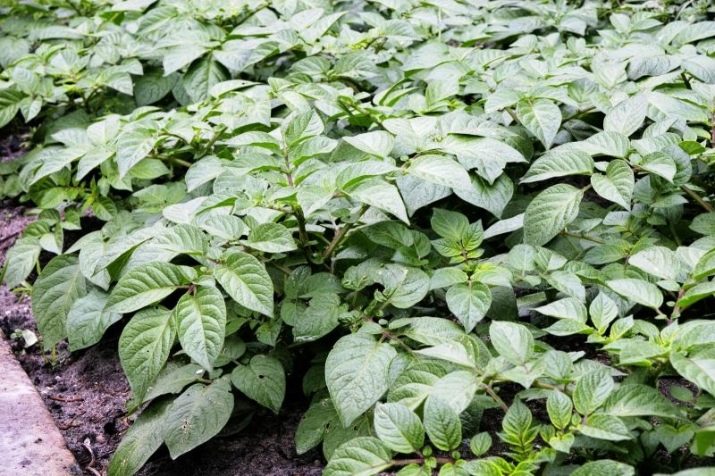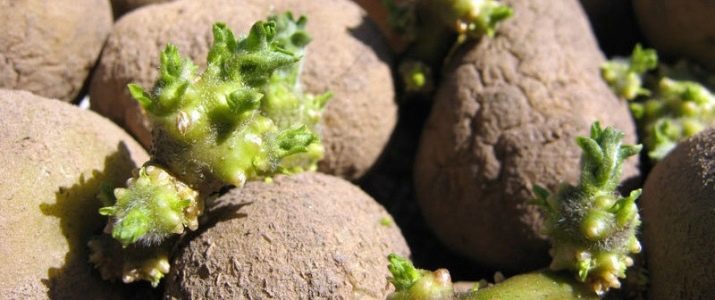Features and cultivation of varieties of potatoes "Red Lady"

Nourishing, tasty, suitable for creating a variety of dishes - it's all about potatoes.Among the variety of varieties stands out "Red Lady". From this article, you can find out what consumers liked so much about the variety, understand its pros and cons, as well as get information about growing and care.
History reference
It is enough to look at the Red Lady potatoes once to justify the exquisite name - the pink skin speaks for itself. The variety was bred in Germany, and officially registered in Russia relatively recently - since 2008. The task for the breeders was set clear - medium-sized roots, which are well tolerated transportation and can be stored for a long time. Painstaking work fully justified itself, and the Red Lady fell in love with gardeners for high-quality and beautiful fruits, disease resistance and unpretentiousness.
By the way, about the conditions - if you look at the data of the state register, you can determine the most favorable zones in Russia for growing this variety of potatoes. These include regions:
- Middle Volga;
- Far Eastern;
- Caucasian;
- Central Chernozem.
When choosing the right place for planting and proper care, from one hectare can be collected from two to five centners of the crop.
Variety description
Bush "Red Lady" is not very high, but the foliage is thick, rich green color. Useful information for gardeners who are in doubt about the planting pattern: the plant does not take up very much space, so there is no need to make large indents. The variety has a characteristic feature - falling undeveloped buds.
This variety is an early one; you can dig up young potatoes after only 45 days. Those fruits that are supposed to be stored for a long time are not affected - they should be removed no earlier than 90 days after planting.
On average, one bush can collect up to 15 potatoes, whose weight can vary from 140 to 150 grams. Each fruit is oval, smooth, with rather thin skin. Despite this, the skin is quite dense and reliably protects from the effects of external factors during transportation and storage. Two points add points to the variety:
- a small number of eyes (and those - only superficial);
- minimum of small fruits in the crop.
If you make a cut of ripe potatoes, you can see a light yellow shade of ripe pulp with a small amount of starch.
Benefits
It has already been said about many advantages of the variety: high yield, marketable appearance, simple conditions for cultivation. Perhaps the main advantage of “Red Lady” experienced gardeners call absolute insensitivity to most diseases. This applies to potato cancer, rust, rot and a variety of viruses.
Like any potato, this variety contains a large amount of useful and nutrients. The taste of the fruit is bright, rich, and they are suitable for the preparation of almost any dish - from crispy chips to the most delicate puree.
If the summer was hot and without rain, the Red Lady will demonstrate one more positive characteristic - the potato will calmly withstand the drought and will not require constant abundant watering.
Disadvantages and diseases
The only disease that this variety is afraid of is late blight. The fruits themselves usually do not suffer, but the tops "take a hit on themselves." To protect the potatoes from the disease, experts advise to pay attention to the funds with copper in the composition. Enough a couple of treatments for the season, and late blight will bypass the plant side.
Typical garden pests - Colorado beetles, wireworms also pose a threat. Save the harvest will help:
- soil fertilizer before planting;
- loosening;
- treatment with special chemical compounds for the destruction of insects.
This is not a disadvantage, but the distinctive feature of the Red Lady variety is the love of sunlight and the need for nutrients. Therefore, it is necessary to provide potatoes with comfortable light conditions and high-quality feeding.
Germination
Without pre-treatment of planting materials can not do. After the selection of tubers - strong, intact, medium size - they are germinated. This can be done by two methods, one of which involves the creation of a greenhouse effect. To do this, you will need plastic bags with pre-made holes for air exchange. In one package lay no more than ten tubers. Due to the increased heat, potatoes sprout quickly, literally in a week.
Another technique will require a longer period. You can sprout potatoes in a well-lit place where there is no damp or cold. Simply lay the tubers in two layers on a flat surface or in small boxes, and evaluate the results in twenty days.
When the germination process is complete, the tubers need to be sorted. Potatoes that have given weak sprouts and which are afflicted with the disease will not be suitable for planting. At this stage, the diseased fruits are easiest to detect, since heat will provoke the development of bacteria.
To disinfect even healthy tubers will be superfluous - for this you can purchase products in specialized stores. Some process them also with growth stimulants.
Pre-fertilizer
What is lacking in soils with an abundance of sand is humus, and the potato needs it. Problems can be avoided if you provide high-quality and proper feeding. Too zealous with it is also not worth it, because the soil overfed with organic matter will not allow the fruit to develop normally.
The beginning of autumn is the best time to fertilize the soil. Of organic fertilizers, gardeners most often use:
- manure;
- bird droppings;
- ash.
Potassium nitrate, superphosphates and ammophos are distinguished from minerals. During the wintering period, both types of fertilizer are sufficiently absorbed by the ground, which will create the most comfortable conditions for a new planting.
Landing rules
If it is not about growing potatoes for one family, but about larger scales, then all agrotechnical rules must be observed. For a start - the place: his choice is determined based on the location of other landings. Thus, potatoes will not yield if they are planted at the site where the solanaceae used to bear fruit. And not only potatoes, but also eggplants, tomatoes, peppers. Crop rotation plays a very important role in potato cultivation, and the new variety requires even more attention.
Having seed tubers next to another variety is not a good idea either. The fact is that when flowering plants begin to pollinate each other, which will adversely affect the quality of the crop, and change its original characteristics.
To find a good "predecessor" on earth for potatoes is simple - it is enough to pick up a zone in which potato pests and pathogens could not spread. For the cultivation of suitable plots, which were previously:
- carrot;
- cabbage;
- cucumbers;
- beet.
Also successful are places where grain and legumes were displayed.
In addition, sandy or sandy sandy soils, an abundance of light and heat are preferred for this variety.
In the spring, when the preparation for planting is in full swing, it is recommended to fertilize each well separately. For this well-prepared and ready-made complexes, and ordinary ash. When buying and using fertilizers from the store, do not neglect the manufacturer's advice. The use of more feeding than required, will not bring benefit. The volume of ash is simpler - just a handful per well.
Planting is carried out according to the following scheme: the distance between plants should not be less than 35 centimeters, and between rows - 60. Despite its undemandingness, the “Red Lady” prefers heat, therefore potatoes should be planted in the ground, heated to at least 10 degrees.
Experienced agronomists do not need to be reminded once again about hilling or weeding - this is a vital necessity for plants.The lack of moisture does not greatly affect the variety “Red Lady”, however, when the tubers begin to form, you should not forget about watering. Three times per season is enough.
Opinion gardeners
Most reviews of this potato variety are positive. Farmers and gardeners practically do not find flaws in the "Red Lady", and all of these positive properties are confirmed. Regardless of whether the potatoes are grown for sale or only for themselves, the yield meets expectations, the tubers delight the eye with a neat oval shape and size. Many people note that it is this variety that gives literally “one-to-one” fruits - neither small ones nor overly large ones can be found.
Among the negative responses you can find only opinions about the lack of resistance of potato to late blight. But. The gardeners themselves agree that in this case the disease is easy to prevent, if you are not lazy to bring preventive measures and take good care of the culture.
For information on how to grow a variety of potatoes "Red Lady", see the following video.































